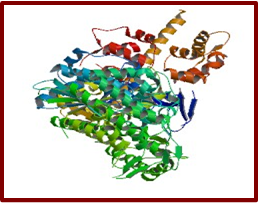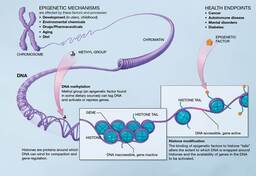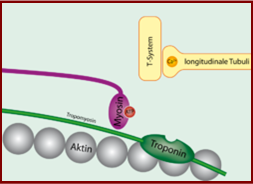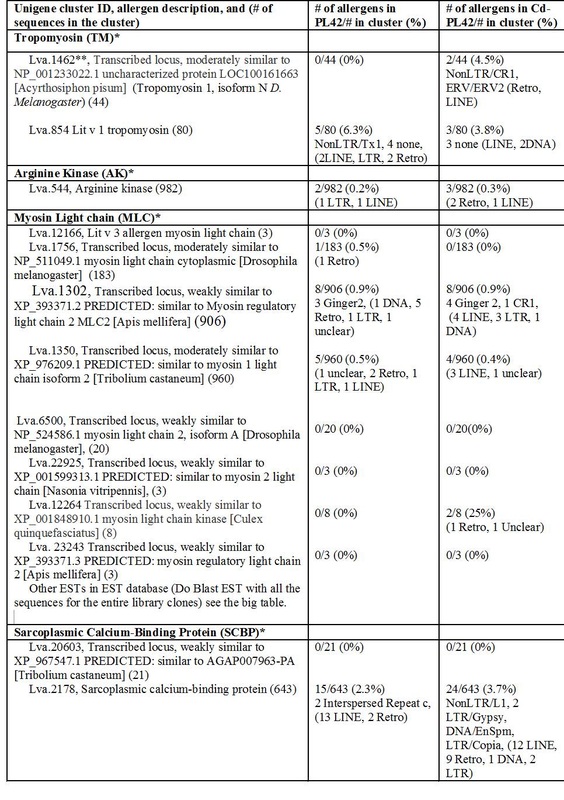SHRIMP ALLERGENS, ENDOCRINE DISRUPTING CHEMICALS (EDCs) AND TRANSPOSABLE ELEMENT (TE) -LIKE REPEATS: A REVIEW
Jacqueline Presedo1*, Alexandra Bowen1, Laura Hake1, Acacia Alcivar-Warren1-3
1Biology Department, Boston College, Chestnut Hill, MA 02467 USA, 2Environmental Genomics, Inc. Southborough, MA 01772, 3FUCOBI (Fundacion para la Conservacion de Biodiversidad Acuatica y Terrestre), Guayaquil, Ecuador; E-mail: [email protected]
Shrimp allergy is one of the most common food allergies in the United States. Shrimp allergy is an IgE-mediated Type I allergy, a long-lasting disorder, which usually persists throughout life, and is often associated with severe reactions, including life-threatening anaphylaxis. The four known shrimp allergens are tropomyosin (TM), arginine kinase (AK), myosin light chain (MLC), and sarcoplasmic calcium-binding protein (SCP). This review seeks to thoroughly examine the current literature about the allergen genes and the potential epigenetic effects of EDCs and TEs on allergen expression. TM (Pen a 1) is the major shrimp allergen and TM (Lit v 1) contains seven IgE-binding regions, AK (Lit v 2) contains seven IgE-binding regions, MLC (Lit v 3) contains five IgE-binding regions, and SCP (Lit v 4) contains three IgE-binding regions.1 There are a large number of allergen-related ESTs for L. vannamei in the UniGene database. MLC is the most variable of these allergens, with six clusters of thousands of related sequences in the UniGene database. TM had two clusters, AK had one cluster, and SCP had two clusters of related sequences. Some of these allergen genes contain repeats that resemble those of vertebrate TEs, which could play a role in the body’s recognition of foreign DNA and/or the over expression of the allergen genes. Different TE-like repeats were identified in some of the EST sequences of particular allergens and are being used to develop EST-SSR markers for the linkage map of L. vannamei (ShrimpMap2).2-3 Most of the shrimp consumed in the United States is either farmed or wild caught in developing countries and is often contaminated with pathogens and EDCs, including heavy metals such as cadmium and persistent organic pollutants (POPs), which are known to have negative health effects in most living organisms.4-5 It is possible that contaminants such as viruses and EDCs induce the expression of TEs in the shrimp genome, which in turn affects mRNA expression levels of allergen genes in edible muscle tissues. Stress-sensitive TEs are potential allergy biomarkers. Most of the shrimp allergens appear to have been isolated from cDNA libraries prepared with RNA of specific pathogen-free (SPF) L. vannamei of the US Marine Shrimp Farming Program. Some allergen EST-SSR markers are polymorphic in wild shrimp of Ecuador and in cultured SPF shrimp, making them useful for population genetics, traceability, and molecular breeding to develop a hypoallergenic shrimp line.
1Ayuso et al. 2010. Greater epitope recognition of shrimp allergens by children than by adults suggests that shrimp sensitization decreases with age. J Allergy Clin Immunol. 125:1286. 2Presedo et al. Searching for hypoallergenic shrimp: Polymorphisms in expressed sequence tags (ESTs) homologous to shrimp allergens. IMSEGI Session, Aquaculture America 2011, New Orleans, Feb 28-March 3, Abst. 492. 3Bowen et al. Transposable element-like repeats in allergy-causing genes from SPF L. vannamei postlarvae - development of allergen EST-SSRs for linkage mapping. Aquaculture America 2012, Las Vegas, Feb 29-March 3, Abst. 4Keating et al. 2007. Histological findings, cadmium bioaccumulation, and expressed sequence tags (ESTs) in cadmium-exposed L. vannamei postlarvae. J Shellfish Res 26:1225. 5Airaksinen et al. 2011. Association between type 2 diabetes and exposure to persistent organic pollutants. Diabetes Care 34:1972-9.
Fuente: https://www.was.org/WasMeetings/meetings/ShowAbstract.aspx?Id=25577
Fuente: https://www.was.org/WasMeetings/meetings/ShowAbstract.aspx?Id=25577
Download full file
| presedo_et_al.shrimp_allergens_edcs_tes_diapositivas_16.10.2012.pdf |
TRANSPOSABLE ELEMENT-LIKE REPEATS IN ALLERGY CAUSING GENES ISOLATED FROM SPF Litopaneaus vannamei POSTLARVAE EXPOSED TO 1 PPM OF CADMIUM – DEVELOPMENT OF ALLERGEN EST-SSRs FOR LINKAGE MAPPING
Alexandra Bowen1*, Jacqueline Presedo1, Laura Hake1, Acacia Alcivar-Warren1-3
1Biology Department, Boston College, Chestnut Hill, MA 02467 USA, 2Environmental Genomics, Inc., Southborough, MA 01772, 3FUCOBI (Fundación para la Conservación de Biodiversidad Acuática y Terrestre), Guayaquil, Ecuador
1Biology Department, Boston College, Chestnut Hill, MA 02467 USA, 2Environmental Genomics, Inc., Southborough, MA 01772, 3FUCOBI (Fundación para la Conservación de Biodiversidad Acuática y Terrestre), Guayaquil, Ecuador
A large number of ESTs with homology to the shrimp allergen myosin light chain (MLC) have been reported from cDNA libraries prepared from muscle of specific pathogen-free (SPF) Litopenaeus vannamei exposed to White Spot Syndrome Virus and Taura Syndrome Virus.1-2 The number of people with shrimp allergies in the US has increased in the past 20 years, and most shrimp consumed by Americans is imported. Availability of specific pathogen-free (SPF) L. vannamei, the most widely farmed shrimp species around the world, has helped to control viral diseases. No information on the potential risk of SPF shrimp on increased allergen expression has been reported. The toxic metal cadmium (Cd) is an important environmental pollutant, a carcinogen, a metallohormone, and an endocrine disruptor. Cd accumulates in testes, prostate, renal epithelial cells and liver, binds to DNA, and may cause heritable mutations. Chronic, sublethal Cd levels may be harmful to human health.
|
Table 1. Expressed Sequence Tags (ESTs) Homologous to Shrimp Allergens in the Litopenaeus vannamei UniGene database.
|
Cd increases oxidative stress, induces the expression of transposable elements (TEs) such as LINE non-LTR retrotransposons, may play a role in diabetes occurrence, and exacerbates allergic reactions. Cd accumulates in the body of L. vannamei in proportion to environmental concentrations.3 Baseline expression data on the potential effects of Cd on shrimp health and growth suggested a complex interaction between environmental conditions and host genetic background.3 To begin to understand the molecular mechanisms involved in the increased prevalence of shrimp allergies, basic knowledge of shrimp genome structure is needed. We hypothesize that Cd induces the expression of allergy-causing genes and genome rearrangements mediated by TEs. The specific aims of this study were to (a) determine if the number of allergen genes is increased after Cd exposure, (b) characterize the TE-like repeats in shrimp allergens, and (c) develop EST-SSRs for mapping of shrimp allergens. ESTs were isolated from cDNA libraries constructed using the cephalothorax of SPF, untreated L. vannamei postlarvae stage 42 (PL42) and Cd-treated (1ppm) postlarvae (Cd-PL42). Results showed no difference in the number of allergen genes isolated from control and Cd-treated cDNA libraries from cephalothorax (Table 1). This is contrary to the large number of MLC-related ESTs isolated from the cDNAs cloned using muscle of SPF juveniles challenged with WSSV and TSV. Homology searches showed a larger number of unique EST sequences in Cd-PL42 than in control PL42. These ESTs may represent new TE-mediated loci or TEs, which may play a role in allergic reactions. Most allergen ESTs contained TE-like repeats similar to those found in Ginger2 DNA transposon, endogenous retrovirus (ERV2), and LINE and CR1 non-LTR retrotransposons. Preliminary results on the utility of allergen EST-SSR markers for linkage mapping will be presented. |
1Alcivar-Warren et al. 2007. Characterization and mapping of expressed sequence tags isolated from a subtracted cDNA library of Litopenaeus vannamei injected with White Spot Syndrome Virus. J. Shellfish Res 26:1247. 2Alcivar-Warren A, W Warren. 2009. Sex, retrotransposons and disease tolerance – A review of the genetics and genomics of the penaeid shrimp. World Aquaculture Society, Veracruz, Mexico, Sept 2009, Abst #931. 3Keating et al. 2007. Histological findings, cadmium bioaccumulation, and isolation of expressed sequence tags (ESTS) in cadmium-exposed, specific pathogen-free shrimp, Litopenaeus vannamei postlarvae. J. Shellfish Res 26:1225.
This research was funded in part by Environmental Genomics, Inc., the FUCOBI Foundation, Boston College, and USDA-CSREES (through a grant to the USMSFP, to A-W).
Fuente: https://www.was.org/WasMeetings/meetings/ShowAbstract.aspx?Id=25518
Fuente: https://www.was.org/WasMeetings/meetings/ShowAbstract.aspx?Id=25518
Download Full File
| bowen_et_al_sequence_variations_in_shrimp_allergens.pdf |








